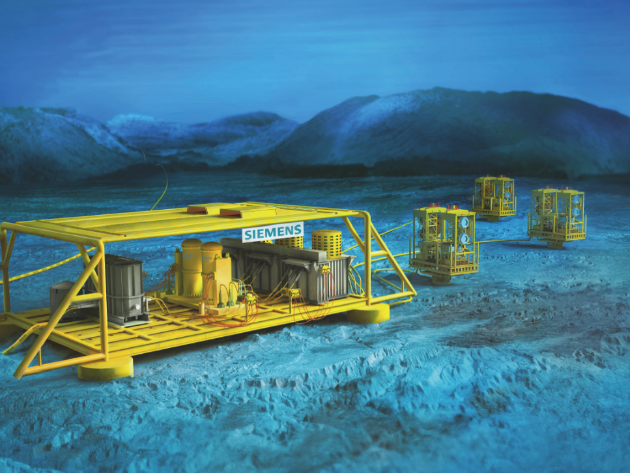
Automated, unmanned, and submerged some 3,000m below the surface, the offshore oil and gas platform of tomorrow might sound improbable but engineers at a Siemens research centre in Trondheim in Norway are working on plans to make it a reality.
At the heart of the project lies the familiar concept of subsea processing, where a number of functions once confined to offshore production platforms – including water removal and re-injection, boosting of well fluids and sand and solid separation – are performed undersea. The benefits of this are numerous, according to Siemens’ head of subsea power Bjørn Rasch.
“If you look at the world today, we suffer from very low rates of recovery from subsea reservoirs,” he says. “Twenty percent of the oil and gas will be produced but the rest you just can’t get out, at least not from deep sea reservoirs.”
Recovery rates are low, Rasch adds, because in an oil well you don’t have just oil. “You have water, gas and this mixture has to be transported up to a platform,” he says. “That creates a lot of back-pressure on the reservoir and poor flow conditions. By introducing a subsea booster pump, for example, you can reduce the well pressure, improve the flow conditions and increase the recovery rate of the well. There is a huge value potential if you are able to increase the recovery rate by just a few percent.”
Unrealised potential
Of course, subsea processing is nothing new. For at least 20 years the technology has been described as one of the most promising developments in the offshore industry. But while “it has been delivered to the market for many years, it is still not utilised that frequently,” says Rasch.
One of the problems, Rasch says, is that “until today subsea processing has been powered through a direct connection to a topside or onshore platform. In many of the identified fields where this technology can be introduced you don’t have the possibility to supply the required power for these pumps.”
The next phase of subsea processing technology, Rasch adds, is “to actually distribute power more effectively at the sea bed so you can have a genuine subsea power solution.”
Subsea power distribution: The next step forward
This is what Siemens and other companies, including ABB, are currently working on. When delivered to market, Rasch says, Siemens’ product will represent a major step forward in realising “the dream of operators” to have a fully unmanned offshore platform.
“We will be able to deliver a genuine subsea to market solution where you actually produce from the well all the processing that you need to transport the oil directly to the market,” he says. “You can then power all this subsea processing directly from the shore. You won’t need any offshore installation at all.”
Alongside the expected recovery gains and safety improvements, Rasch says the solution will also help the industry reduce cost.
“In some deepwater scenarios you have several consumers with very complicated power needs and very expensive cable costs,” he says. “By introducing subsea power distribution you can actually reduce the number of cables you need to go from topside to subsea.”
Putting these functions undersea and delivering a fully automated platform could also reduce many of the safety risks associated with offshore oil and gas extraction. In the last few months alone offshore workers have lost their lives in platform accidents in both the North Sea and Azerbaijan.
Overcoming the challenges
There are challenges, however. “The most obvious is having high voltage electricity together with water,” says Rasch. “I think everybody knows that is not something that matches very well. In this environment you also have very deep water with high pressure and you want to distribute electricity. It is not easy.”
Siemens’ current solution is to put all of the electronics inside a pressure-compensated, fluid-filled environment. “We have a kind of barrier against the water,” Rasch explains. “This is one of the biggest challenges and it is also a very time-consuming process. We have to qualify all of these components and really demonstrate to the market that we have a solution that works under these specific conditions.”
Another challenge is actually maintaining the product once it is installed under water. “If you need to take something out you can’t just send somebody to go down and check on it because everything is 3000m below the surface,” Rasch says. “It is very challenging and expensive to do any kind of intervention or service so you need to create systems which have built in redundancy and which are extremely reliable.”
None of this is impossible, though. According to Rasch, Siemens is now in “the final qualification stage” for its power distribution product, having already assembled a prototype.
“The main component we are using is a subsea transformer which actually takes high voltage AC power and transforms it down to a medium voltage,” he says. “Then we have a medium voltage switch gear which connects and disconnects the different consumers of power. And then we have the third main part: the variable speed drive which controls the speed of the pump. All of these components are now assembled in our workshop in Trondheim and we are currently doing testing on the equipment.
“This summer we will start system integration tests, and when we have done that successfully, we will move the equipment to a test location in Trodheim harbour, where we will operate all of the equipment under water at shallow depths.”
With different companies developing competing systems to take the offshore oil and gas platform underwater, the race is certainly on. Will Siemens be first? “Time will tell,” Rasch laughs. “There is a competition to be first to the market but it is a very challenging situation and we see a lot of potential in the years to come.”



